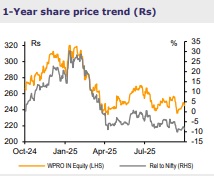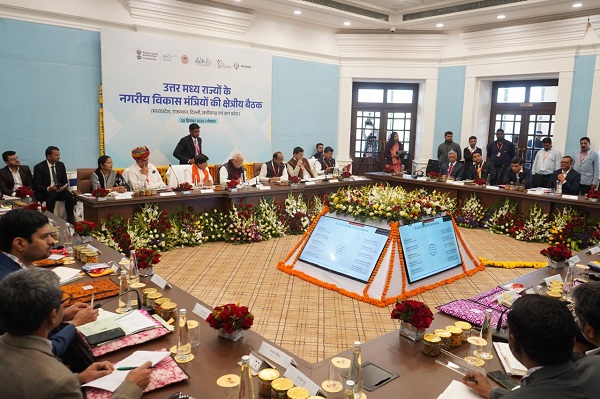Reduce Wipro Ltd For Target Rs. 250 By Emkay Global Financial Services Ltd
.jpg)
Steady Q2; mid-point of guidance lacks acceleration
Wipro reported steady operating performance in Q2, though a one-off provision for client bankruptcy led to a miss on reported EBITM. IT Services revenue grew 0.7% QoQ to USD2.6bn (0.3% CC), a tad above our expectations. IT Services’ EBITM came in at 16.7%, slightly lower than expected; however, adjusted for a one-off client bankruptcy provision (50bps), it was ahead of expectations. Deal intake remained strong at ~USD4.7bn in Q2 (includes large-deal bookings worth ~USD2.9bn), with book-to-bill of 1.8x. Wipro guided for -0.5% to 1.5% CC QoQ revenue growth in Q3, missing the anticipated acceleration at the midpoint of its guidance. Clients are focusing on cost optimization, vendor consolidation, and efficiency through AI, presenting opportunities in both runand-operate and build-and-transform services. The mgmt remains focused on converting strong backlog into revenue while maintaining operational discipline to ensure profitable growth. It suggested pressure on margins in the near term due to anticipated ramp up of competitively-priced large deals and initial investments in such deals, although it plans to operate within a narrow range. Integration of the Harman DTA acquisition is likely to dilute margin by 60bps. We tweak FY26-28E EPS (a <1% change), factoring in the Q2 performance; retain REDUCE with TP of Rs250 at 18x Sep-27E EPS.
Results Summary
Wipro’s IT Services revenue grew 0.7% QoQ (0.3% CC) to USD2.6bn. IT Services EBITM declined by 60bps QoQ to 16.7%, impacted by a provision of Rs1.2bn made toward bankruptcy of a customer. Adjusted for this, margin stands at 17.2% (down by 10bps QoQ). Overall EBITM increased by 60bps QoQ to 16.7% as against our estimate of 16.8%. The anticipated headwinds from large deal ramp-ups and growth investments were partially mitigated by favorable currency and operational improvements, including improved utilization, reduced attrition, and higher FPP productivity. The Consumer, EMR and Health verticals declined 1.7%, 1.5%, and 0.2% CC QoQ, while BFSI as well as Tech and Communications rose 2.2% and 0.8%, respectively. Of its strategic market units, APMEA, Europe, and Americas 1 reported sequential revenue growth of 3.1%, 1.4%, and 0.5% CC QoQ, respectively, while Americas 2 fell 2.0%. Total headcount was up 1% QoQ at 235,492. Attrition (TTM) fell by 20bps QoQ to 14.9%. What we liked: BFSI recovery, strong deal intake. What we did not like: Weakness in 3 of the 5 verticals.
Earnings Call KTAs
1) The management highlighted that ramp-ups from large deal wins are providing positive momentum, with the guidance midpoint turning positive for the first time in several quarters. AI powered transformations, cost optimization, vendor consolidation, and consulting-related programs led the demand in Q2. 2) The company’s BFSI deals are a mix of renewals, expansions, and net new wins. Two deals called out in Europe are netnew. The management continues to see momentum in BFSI, driven by clients focusing on cost optimization, vendor consolidation, legacy modernization, and scaled deployment of Agentic AI. 3) Tariff uncertainties are prompting supply chain reassessments in consumer, energy, and manufacturing. Meanwhile, Technology & Communications focuses on AI adoption and industry-specific solutions, while Healthcare continues to perform strongly amid structural changes in the US. 4) Americas 2 saw a decline this quarter; however, confidence in future growth remains strong as several deals secured in H1FY26 are now beginning to ramp up. 5) Europe returned to sequential growth in Q2, led by BFSI, with the Phoenix deal expected to drive additional revenue from Q3. The management highlighted strong momentum in Europe through multi-year deals with leading financial and logistics companies, leveraging AI and digital tools to modernize operations and drive efficiency. 6) Capco grew 3.2% YoY, with gains also seen QoQ on the back of momentum coming from newer markets like LatAm and APNEA. 7) APNEA growth was led by India, Australia, and Southeast Asia. 8) Wipro signed 13 large deals this quarter, driven by vendor consolidation, AI-powered transformation, and consulting-led programs; these include two megadeals – one each in Healthcare and BFSI. These deals strengthen the company’s presence and result in growth opportunities ahead. 9) The H1 deal flow comprised account renewals, renewals with extended pipelines, and net new deals, with the two European deals being net new. In Q2, there were two net new deals, six renewals, and the rest were a combination of renewals with scope expansions. 10) The management expects short-term margin pressure from growth investments, large deal ramp-ups, and the Harman DTA acquisition (a 60bp dilution). Ongoing productivity and efficiency initiatives are expected to offset these pressures, keeping Q3 margins within a narrow band and improving over time. The mgmt identified three margin levers—utilization, FPP profitability, and SG&A optimization—to offset seasonal headwinds in Q3 and maintain adjusted operating margins within a narrow range. 11) The company highlighted three specific AI solutions: AutoCortex (automotive), Wealth AI (BFSI), and Payer AI (healthcare). 12) In the US, over 80% of the workforce is localized, with limited dependence on H-1B visas (around 250).

For More Emkay Global Financial Services Ltd Disclaimer http://www.emkayglobal.com/Uploads/disclaimer.pdf & SEBI Registration number is INH000000354






















